Our key themes and positions for 2024

Wilsons Advisory
The inflation outlook, interest rates and bond yields have been an integral part of varied performance of sectors and stocks in 2023. Our focus, and positioning, in 2024 will be based on a lacklustre period of economic growth and the potential for central bank cuts in the latter half of the year.
Slower growth in 2024
- Top line growth slows for cyclicals.
- Downgrade cycle accelerates for cyclicals in a slowing economy (especially after a year of resilience).
- Earnings growth becomes scarcer
- Position for stocks with resilient earnings growth over the next 12 months.
How to position
In our base case of a slowing economy, resilient growth is key. We favour high-quality, economically-insensitive names with recurring/defensive revenue and good pricing power that should see them through a more lacklustre period for growth. These stocks can be found across several sectors, such as healthcare, insurance, tech, telecoms and infrastructure.
Figure 1: The portfolio is positioned for stocks with resilient earnings growth over the next 12 months. Insurance and healthcare are top picks
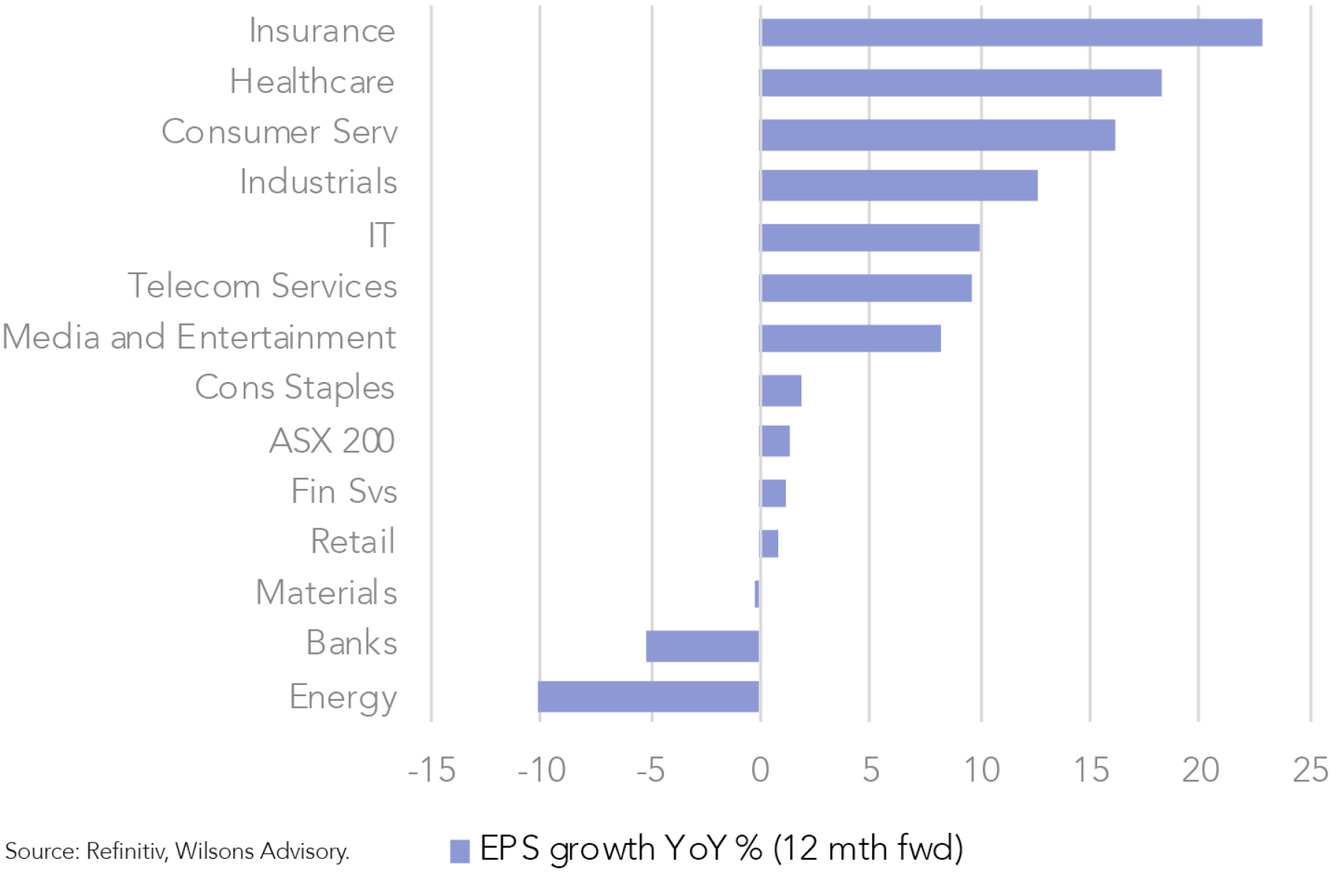
Central banks pivot
- There is a plausible scenario that central banks will cut rates as inflation continues to slow to a level where policymakers are more comfortable.
- The market is now pricing 4 US Fed cuts by the end of next year, with the first expected in the first half.
- The Reserve Bank of Australia (RBA) is expected to cut once in the latter stages of 2024.
When to position?
Investors will likely position themselves ahead of expected cuts.
The US Fed cuts may be the focus of the market over the next 6 months and this should benefit global cyclicals such as resources and stocks with offshore cyclical exposure, as long as global growth remains positive. US Fed cuts should also support growth stocks as long duration stocks recalibrate further to lower or more stable bond yields. Our preference here is towards global focused quality industrials - James Hardie Industries (ASX: JHX), Aristocrat Leisure Limited (ASX: ALL), Amcor (ASX: AMC).
Domestic cyclicals should perform well once the market perceives RBA cuts are imminent, coupled with a slowdown rather than a recession. As the slowdown gathers momentum over the next 6 months, there could be a good opportunity to rotate from defensives to domestic cyclicals. However, pedestrian growth prospects and heightened potential for further downgrades are likely to remain headwinds for cyclical sector returns over the next 6-9 months, outweighing the prospects of rate cuts.
Figure 2: Cyclical sector multiples have held up well in the past year, keeping us cautious into a slower 2024. Resilient growth sectors like healthcare and insurance look attractive vs their 5-year average

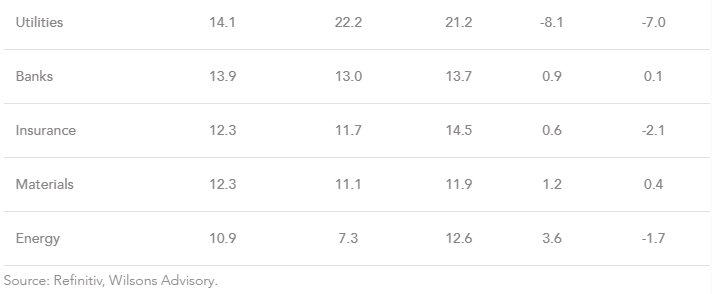
Key thematic – Cost disinflation
Despite concern over the top line over the past 12-18 months, costs have been a key driver of earnings downgrades, but also an underappreciated source of upgrades.
Rising labour and rent costs have been a headwind for earnings in 2023. While these pressures are expected to ease over the next year, they will continue to be relevant during the February and August reporting seasons, particularly impacting sectors with higher employee costs, such as banks, consumer discretionary, and consumer staples.
Figure 3: Wages continue to be a headwind for companies into 2024; we expect labour costs to ease over the next 12 months
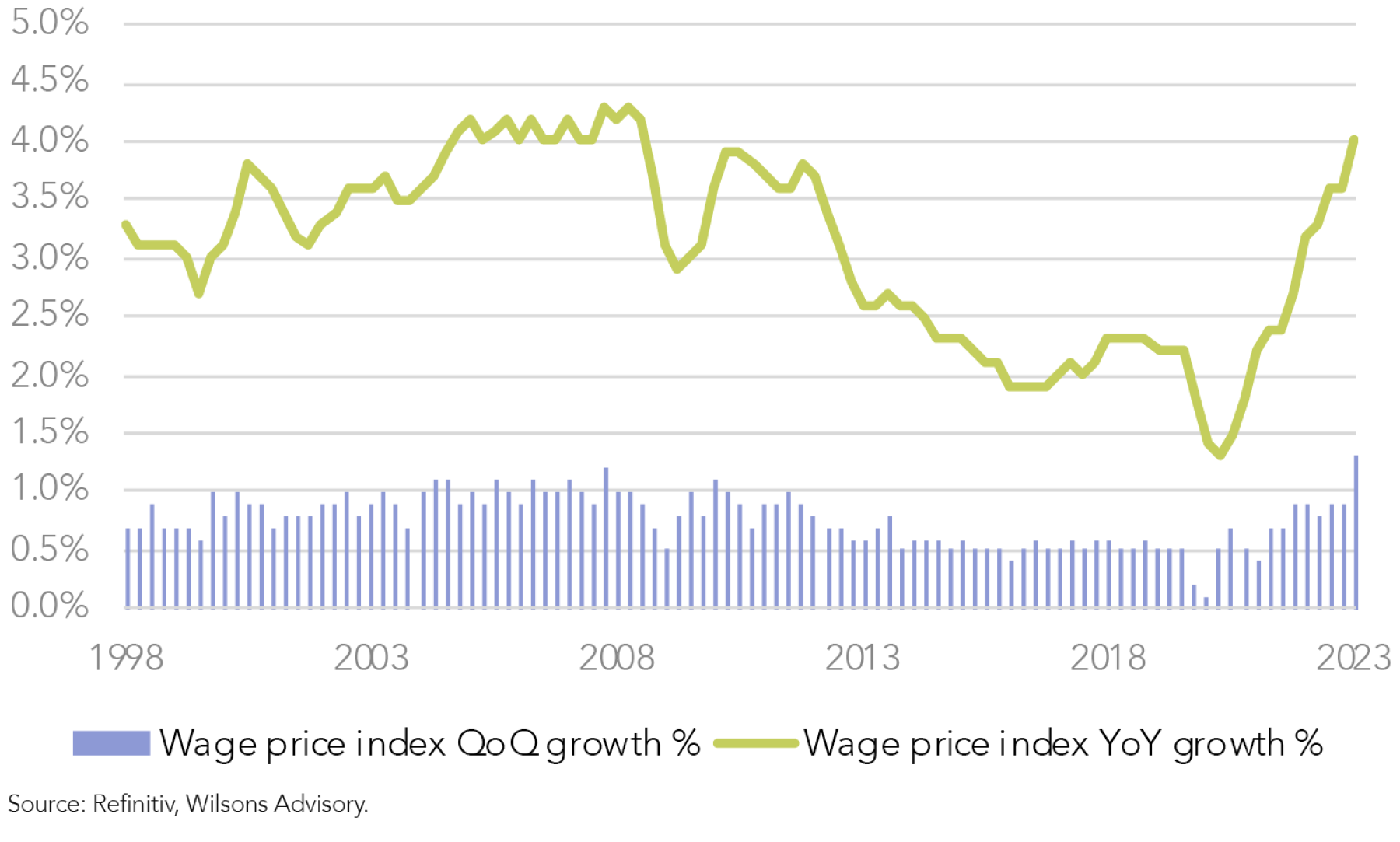
Pricing power has been the key to outrun cost inflation. While tech and companies like Telstra (ASX: TLS) also have a high percentage of labour costs, the ability to pass these costs onto customers has been imperative to maintaining margins. This will be no different in 2024.
We anticipate earnings tailwinds from cost disinflation, or even deflation. Growing evidence suggests that freight, raw materials, and electricity costs are all declining. We have positioned ourselves towards James Hardie (ASX: JHX) and Collins Foods (ASX: CKF), both of which have experienced margin expansion (exceeding consensus expectations) due to lower freight and raw material costs.
Figure 4: Freight costs are becoming a tailwind for companies earnings into 2024
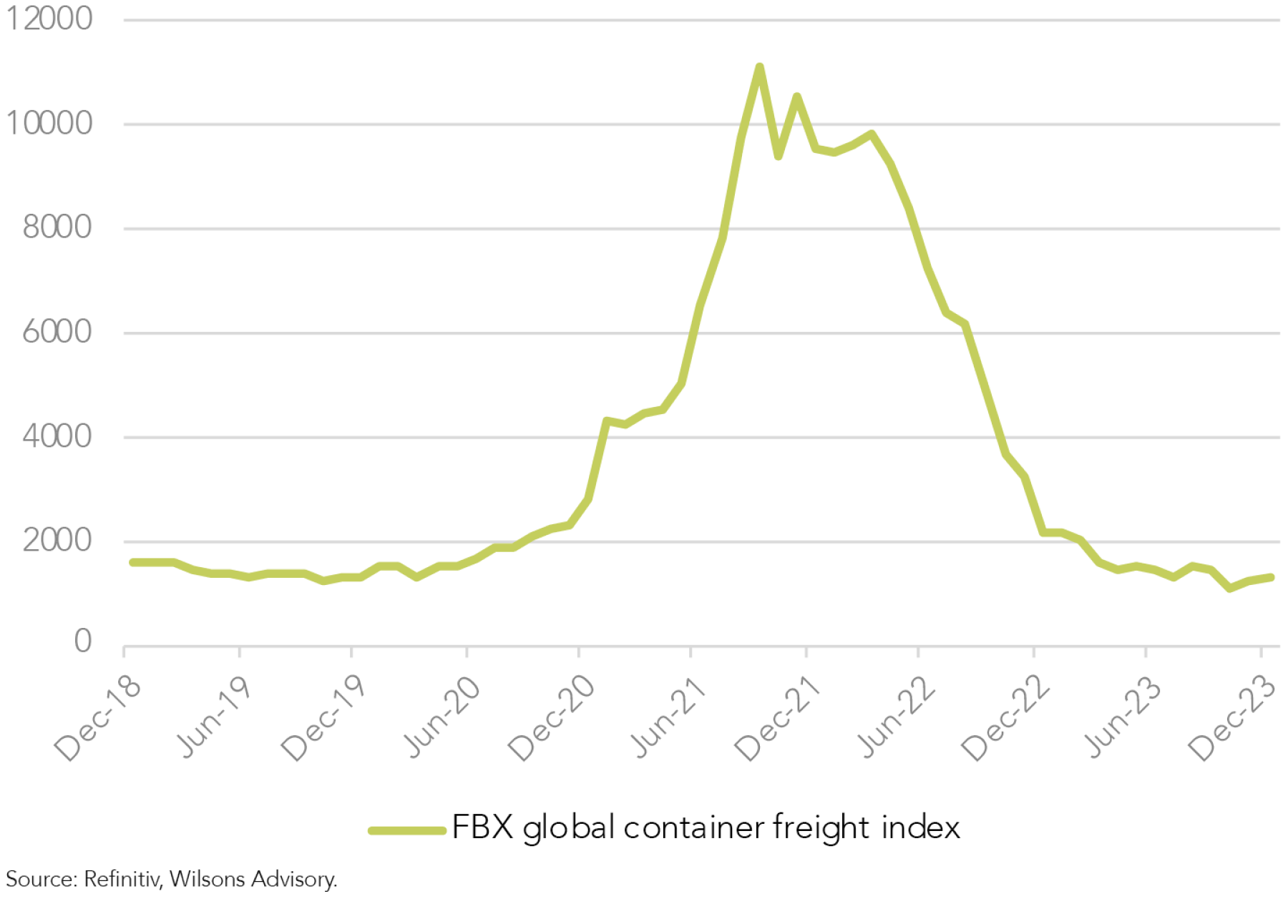
Amcor (ASX: AMC) is another stock added recently. We expect AMC to report improved margins in the first half of 2024.
This key thematic has been largely ignored by the market, but we are confident that it will soon be recognised for its significance.
Sector pick: Healthcare - Focus back on fundamentals to support revival
Healthcare has been the worst performing sector of 2023, driven by a combination of headwinds including post-pandemic demand normalisation trends, margin pressures amidst a challenging cost environment, and market concerns around the potential structural impacts that the increased usage of GLP-1 weight loss drugs could have on the total addressable markets for a range of drugs/devices.
Heading into 2024, healthcare is well positioned to outperform considering the sector’s strong earnings growth prospects amidst a slowing economic cycle, highly attractive valuation multiples, and our expectations that excessive hype around GLP-1s will ease, allowing investors to focus back on the attractive fundamentals of the local healthcare sector.
Strong earnings growth a key appeal in a benign earnings environment
As a structural growth sector, healthcare is well placed to outperform amidst a slowing economic/earnings cycle as earnings growth becomes increasingly scarce across the ASX 200.
In FY24 and FY25, the healthcare sector is expected to deliver earnings per share (EPS) growth of 24% and 18%, which represents a significant premium to broader market EPS growth expectations of -6% and 5%, respectively. Taking a longer-term view, we expect healthcare companies to continue compounding their earnings at an above-market rate, supported by the tailwinds that will drive increasing demand for therapeutics and medical devices in the coming decades.
Given the structural earnings growth available within the sector, healthcare has historically outperformed when broader market earnings growth has been benign or negative, which we expect to be the case in FY24. In our view, this backdrop positions healthcare to outperform over the next 12 months.
Figure 5: Large cap healthcare companies are poised to deliver growth well above the market
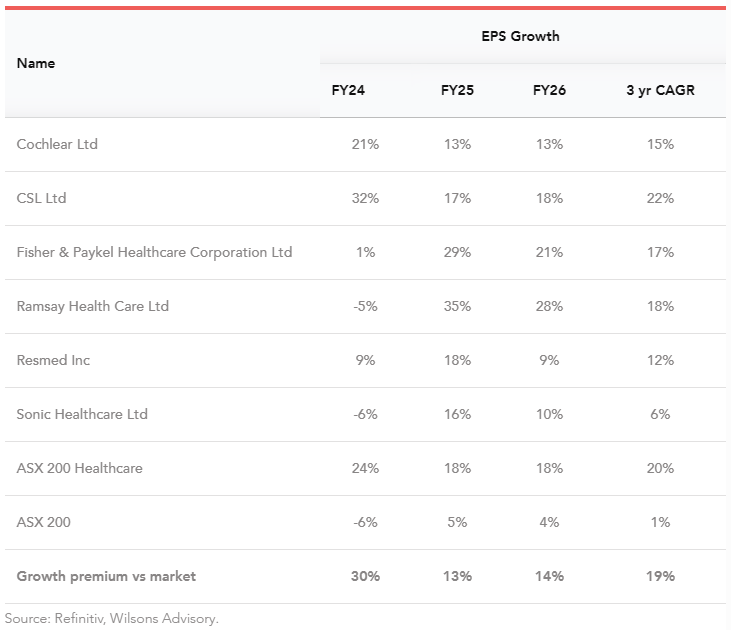
Oversold valuations provide attractive buying
The forward price-to-earnings (PE) multiples of large cap healthcare stocks have generally de-rated to material discounts to their historical averages, most notably ResMed (ASX: RMD) and CSL (ASX: CSL). This provides an attractive entry point for these companies considering their fundamentals remain strong.
Figure 6: Healthcare valuations are broadly below historical averages

Weight loss drug hype should take a back seat in 2024
The most notable headwind for the market performance of the healthcare sector has been investor exuberance around GLP-1 weight loss drugs and concerns that the total addressable markets for a range of healthcare products and services may now be structurally smaller. RMD has comfortably been the biggest ‘loser’ of the ‘GLP-1 mania’.
The obesity drug narrative has been driven by clinical trial related news flow from Eli Lilly (NASDAQ: LLY) and Novo Nordisk’s (NASDAQ: NVO) pipeline of GLP-1 drugs that are targeting obesity and OSA (obstructive sleep apnea) as indications, the latter of which is of particular relevance for RMD.
From RMD’s perspective, we expect the GLP-1 narrative to ease after the release of top-line data from Eli Lilly’s Surmount-OSA phase III trial, which is expected around March 2024.
This will give RMD ‘clear air’ with no further read outs expected over the medium term, allowing the market to return its focus to the continued strength in the company’s underlying fundamentals, including its quasi-monopoly position in the (deeply underpenetrated) CPAP (continuous positive airway pressure) market, with its (formerly) top competitor Philips still sidelined.
GLP-1s join a long list of ‘would be usurpers’ (e.g. bariatric surgery, oral appliances) to CPAP therapy that have all failed to prevent RMD from delivering double digit sales growth (per annum) over the past decade. GLP-1s will have a meaningful impact on the healthcare landscape broadly speaking, although well managed businesses like RMD do not stand still and have demonstrated their ability to adapt in response to a constantly changing healthcare landscape.
We continue to believe GLP-1s offer an incomplete solution to OSA at best, with CPAP likely to remain the standard of care. GLP-1s offer a treatment (requiring ongoing usage) rather than a ‘cure’ to obesity, and treatment remains prohibitively expensive for most individuals at US$1,000 per month.
Figure 7: RMD 12-month forward PE looks attractive
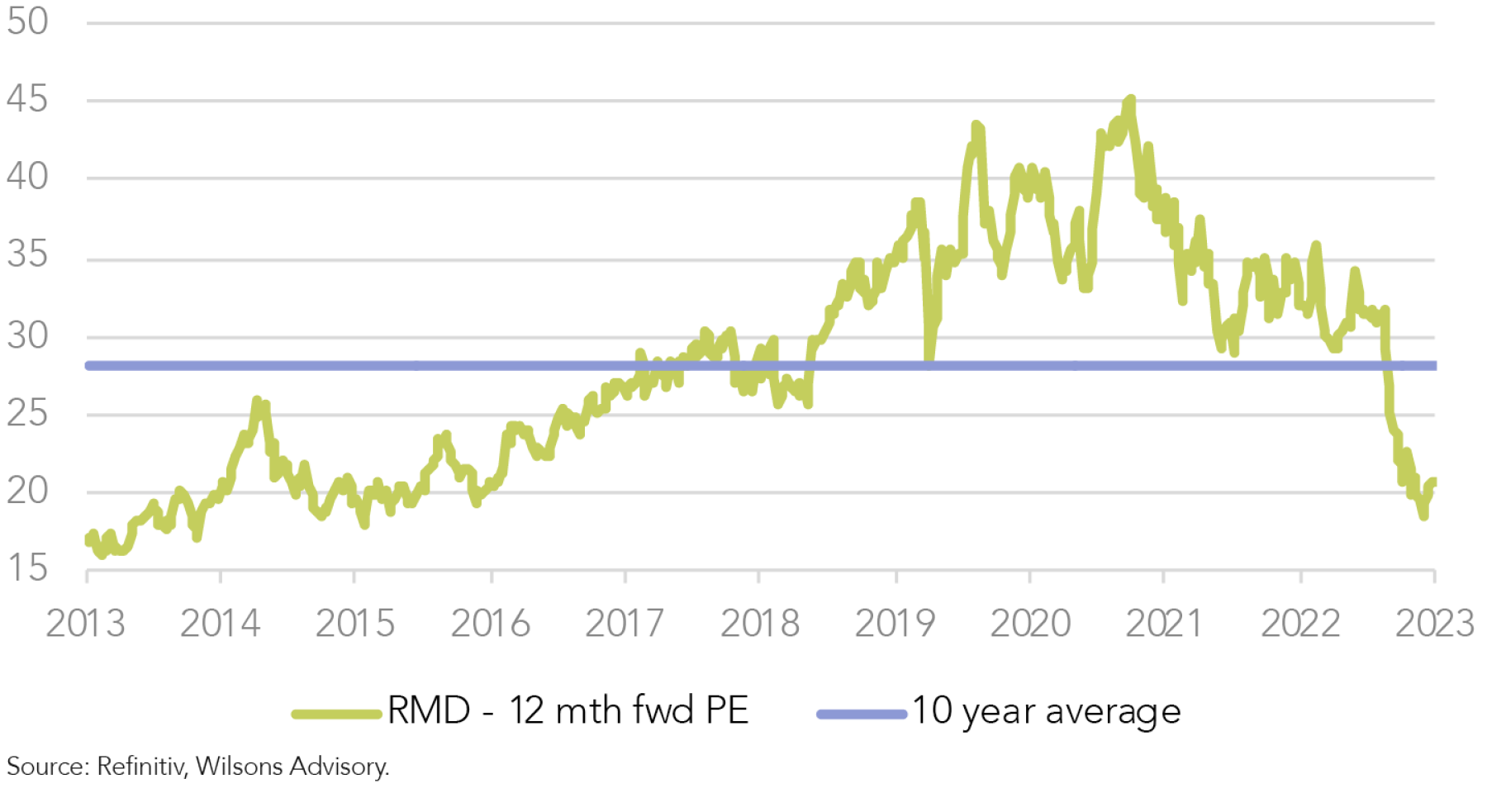
With RMD trading on a forward PE of <21x, a ~40% discount to its 5-year average, there is an excessive amount of pessimism baked into RMD’s valuation, which is inconsistent with our fundamental outlook of the business, thus providing an attractive risk-reward tradeoff at current levels.
Resources: China the key swing factor
We have a view that China can lift economic growth in 2024, supporting the sector.
However, a significant slowdown in global growth and the strength of China’s recovery are risks to the sector over the next 12 months, keeping our overweight modest.
After a disappointing year for China’s economy and its all-important property sector, momentum has improved marginally in recent months, as policymakers have pivoted toward growth stabilisation mode, and recent activity data has come in ahead of expectations.
It is unlikely China will let the economy falter for too long. While there are no signs that policymakers are about to provide ‘big bang’ stimulus, incremental stimulus would be supportive of both iron ore and base metals (i.e. copper, aluminium), as well as ‘green metals’ to some extent (i.e. lithium, rare earths). This would benefit the likes of BHP (ASX: BHP), Mineral Resources (ASX: MIN), South 32 (ASX: S32), Sandfire Resources (ASX: SFR), Lynas Rare Earths (ASX: LYC) and Allkem (ASX: AKE).
Better-than-expected economic data in China should also be supportive of demand for industrial energy and transport fuels, which could provide a tailwind for oil and gas producers including Woodside Energy (ASX: WDS).
Figure 8: Iron ore and gold have been top performing metals in 2023; the 2024 outlook for resources relies heavily on China and the state of the global economy
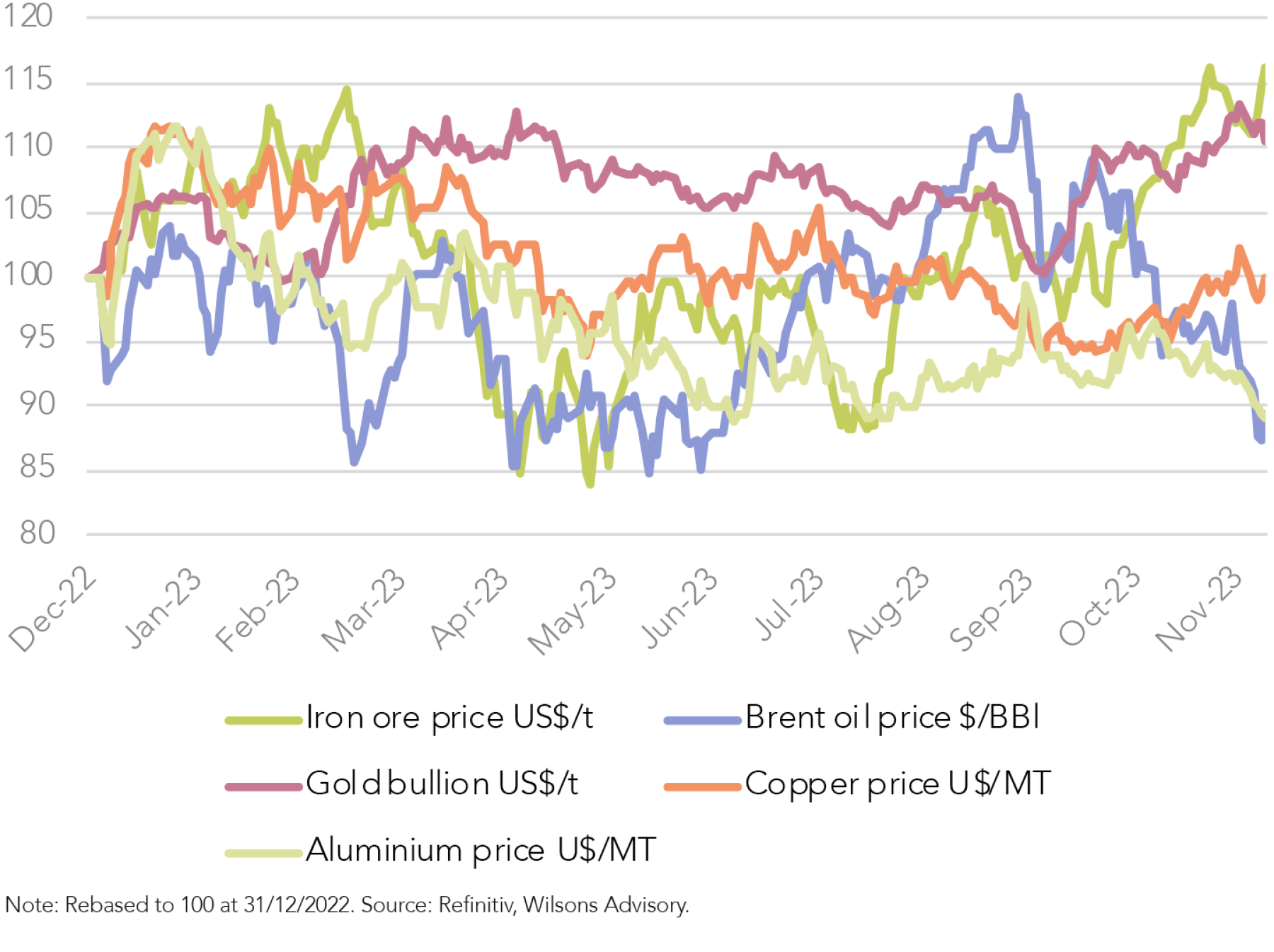
Wilsons Investment Strategy Group wishes all our clients and their families a happy holiday season. We will be offering our insights into investment themes, trends, and opportunities again from late January 2024. Have a wonderful break!
Want more insights like this?
Wilsons Advisory thinks differently and delves deeper to uncover a broad range of interesting investment opportunities for its clients. To read more of our latest research, visit our Research and Insights.
